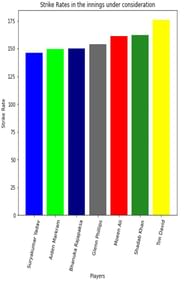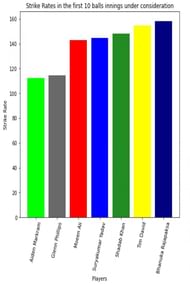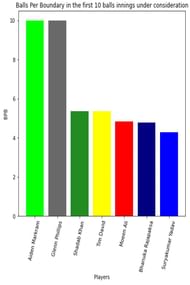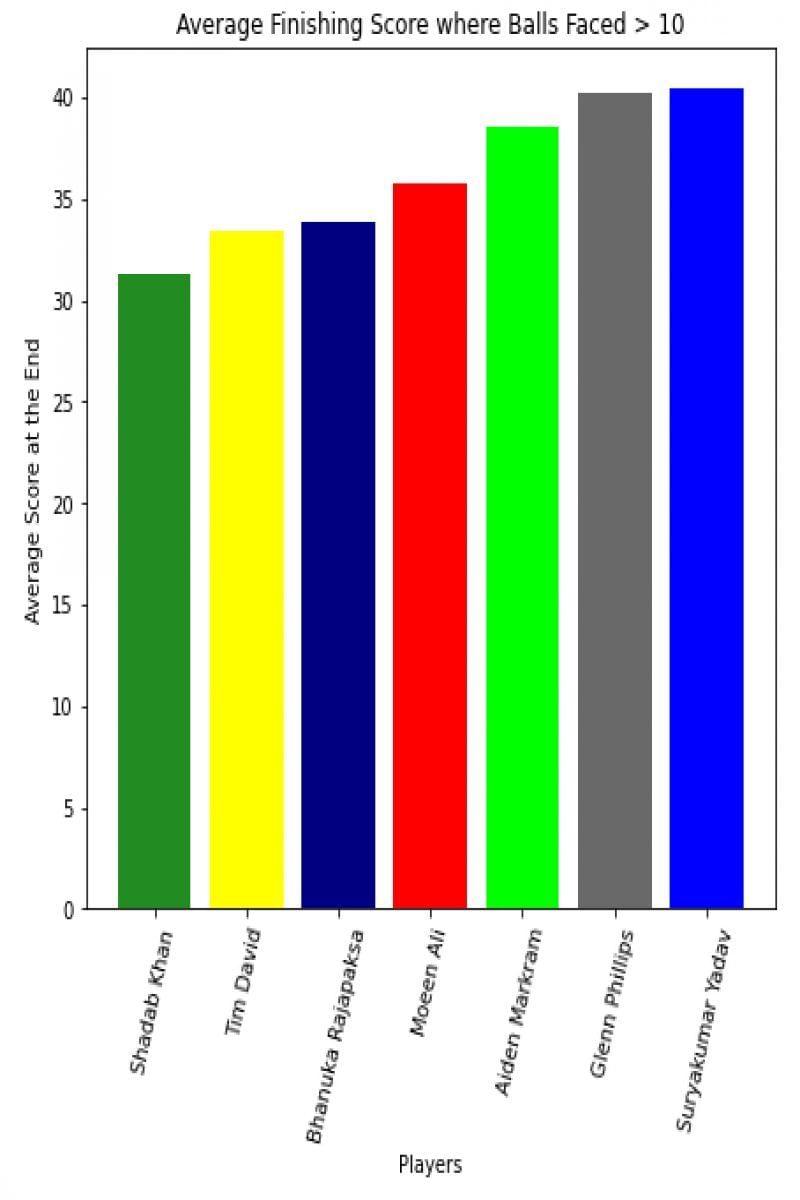After politics and religion, perhaps the most divisive topic in today’s world is the correct approach to playing T20 cricket, or specifically, how to construct a T20 innings. A quick look at the top international teams echoes a unique identity and a unique philosophy to approach the innings with the bat.
On one end of the spectrum is the explosive English approach that consists of undervaluing the wickets or what is often called “modern cricket”. The other side of the spectrum holds teams like Pakistan and India, who tend to overvalue their top-order wickets and prefer going deep into the innings and going explosive at the death.
In terms of length, the longest phase of a T20 innings is the middle overs phase (between overs seven and fifteen). Teams like England tend to attack through the middle overs while teams like India and Pakistan prefer to stabilize their innings in the middle overs to attack heavily at the death.
The batters coming into bat in this phase, specifically those with entry points, play a huge role in the transition from the middle overs to the death. The way these batters approach their innings shows how much their wickets are valued and how much of an impact they can potentially cause.
To isolate an impactful innings, either positively or negatively, only the innings where a batter has faced a minimum of ten balls whilst entering between overs eight and fourteen are considered. The fifteen most recent games that fit the criteria are analyzed.
The players studied in this article are:
1. Suryakumar Yadav (India)
2. Shadab Khan (Pakistan)
3. Moeen Ali (England)
4. Tim David (Australia)
5. Glenn Phillips (New Zealand)
6. Bhanuka Rajapaksa (Sri Lanka)
7. Aiden Markram (South Africa)
Overall Strike Rate vs Strike Rate in the first ten balls
Although a batter’s strike rate almost always increases as the innings goes on, middle-order players often do not have the luxury of a lot of balls at their disposal. Additionally, if they do take too many balls and get out without really going big, not only does their own innings impact teams in a negative manner but the next batters are also left with too little time to make significant contributions.
If we compare the overall strike rate of these players in the innings under consideration, it can be noted that the strike rates are significantly higher and there isn’t much to separate the players.
Australian new-boy Tim David tops the chart with a strike rate of 175.79 whereas even the lowest strike rate on the list is Suryakumar Yadav’s impressive 146.26. It is important to note here that Surya has played three of his fifteen games in the West Indies where scores are considerably lower.
Interestingly, the number four spot for Pakistan has been full of surprises, with a lot of players coming to bat on different occasions. Current reports suggest that Shadab Khan will be the most likely player to bat here as a low-value wicket, with an entry point around the eighth to tenth over.
At the same entry point (in terms of overs), Moeen Ali comes to bat for England, but his batting number is usually at number six. This is a contrasting example of how England under-value their wickets and how Pakistan over-value their wickets.

A look at the second figure, which shows the strike rates of these players in the first 10 balls of the innings, gives deeper insights. While Aiden Markram and Glenn Phillips managed to end their innings at a decent strike rate, their strike rates at the start of the innings were low (112.3 and 114.5 respectively), considering their entry points and the number of other players in similar positions.
In their case, a dismissal after facing ten balls would leave a negative impact on the team's overall innings. Not only would the scoring rate be affected, but the next batters would also not have the luxury of playing themselves in.
Sri Lanka’s young and flamboyant batter Bhanuka Rajapkasa ranks at the top with a strike rate of 158.2 followed closely by David who strikes at 154.67 in the first ten balls of the innings. The next three batters were close to each other with Shadab striking at 148, Surya at 144.67 and Moeen striking at 142.67 at the start of their innings.
Generally, the batters’ strike rates tend to improve as they go further into their innings, which can be seen with all these batters except for Bhanuka Rajapaksa. His strike rate drops, albeit insignificantly, as the innings progresses further.

Balls per Boundary in the first ten balls and the overall finishing score
The initial impact of an innings can also be contextualized by the number of balls a batter takes to get a boundary in the first ten balls. Aiden Markram and Glenn Phillips took ten balls to hit a boundary, which translates to one boundary in the first ten balls of their innings.
Surya tops the list with four balls per boundary at the start of his innings with the rest of the batters not far behind (Shadab and David with five balls per boundary while Moeen and Rajapaksa with 4.5 balls per boundary).
The ability to hit boundaries from the start of the innings is a great advantage, specifically for a player with an entry point in the middle of the innings. Players like Markram and Phillips prefer to build their innings and attack aggressively at the death, as shown by the stark difference in their initial and overall strike rates.
Similarly, Surya and Rajapaksa tend to attempt for boundaries early in their innings after a stable base is provided by the batters before them.
Moeen Ali bats at number six in the English team, which is far lower than the other batters on this list, who mostly bat at four with Rajapaksa and David batting at five. England’s deep batting order combined with the policy of undervaluing their wickets emboldens players like Moeen Ali to play aggressively as well.
Shadab is an interesting case as he is used by Pakistan as a low-value wicket at number four. In the past, he has batted in the lower order while coming out to bat in the final two overs, if that. However, in 2022, his ability to strike off-break bowling at 147.6 and leg-break bowling at an astonishing 209.1 has prompted Pakistan to send him in the middle overs to attack the spinners.
If he gets out while attempting to target his match-up, it doesn't really affect Pakistan’s batting order but if he manages to get quick runs at a decent strike rate, the impact of his innings becomes magnified.

The finishing score of each batter shows what the final score looks like in an innings where they play more than ten balls. The standout performer is India’s middle order striker unironically called “SKY” with a very high average of 40.46. Combining this with both, his initial and overall strike rate shows why he is considered one of the most destructive batters in the modern T20 game.
Phillips and Markram rank higher than the rest of the pack, which strengthens their cases as well. Slower starts can somewhat be made for with a high finishing score at a healthy overall strike rate. The ceiling of their innings might be lower than other players, but the floor is inevitably higher.
Moeen, David and Rajapaksa, who bat lower down the order in teams that do not value their wickets, allow them to attack freely and play aggressively. Arguably, lower finishing scores are made up for with high strike rates in both the initial part of the innings and the overall innings. The floor of their innings might be low, but the ceiling of their innings is significantly higher.
Shadab Khan’s wicket does not hold much value for the Pakistan batting order. A healthy strike rate, especially against spin, shows why Pakistan have used him against his matchups in recent times. Another low-value wicket in Muhammad Nawaz can be used or a proper batter like Iftikhar Ahmed comes in to take his stead.
A success on the other hand, can change the complexion of the innings, even with a knock that lasts a mere fifteen balls. Shadab does not really change the floor, but definitely has the potential to push the ceiling of the innings higher.

Conclusion
Out of all the batters discussed, Suryakumar Yadav shows the best promise as a middle-order batter. A player who scores fast, starts big, and can take the innings deep into the game whilst maintaining the strike rate. Such a player is a luxury to have in any team.
Apart from SKY, there are two major groups of players whose wickets are valued higher, such as Glenn Phillips and Aiden Markram. These players tend to start slowly with low-risk, low-reward options, but can score at a much bigger strike rate once they are settled. An early dismissal might be problematic for their team, but their averages show how often they take the game deeper.
Players like Rajapaksa, David and Moeen tend to undervalue their wickets as they play in teams that bat deep and prefer to attack in the middle overs. A failure for such players would not come at the cost of many balls. However, the volatility of this approach can also cause teams to over-attack and lose too many wickets with a lot of overs to go.
Follow IPL Auction 2025 Live Updates, News & Biddings at Sportskeeda. Get the fastest updates on Mega-Auction and cricket news
